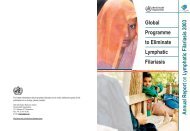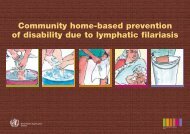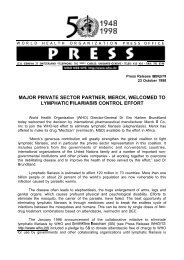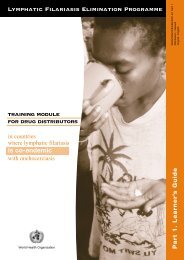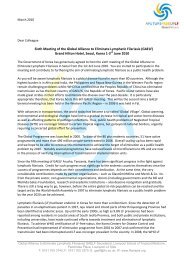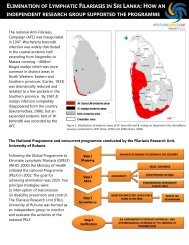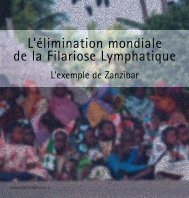English - Global Alliance to Eliminate Lymphatic Filariasis
English - Global Alliance to Eliminate Lymphatic Filariasis
English - Global Alliance to Eliminate Lymphatic Filariasis
You also want an ePaper? Increase the reach of your titles
YUMPU automatically turns print PDFs into web optimized ePapers that Google loves.
REPORT OF THE 6 TH GAELF MEETING, JUNE 2010<br />
Half-time Strategy:<br />
Major Technical Challenges<br />
Chair: Dr. Frank Richards<br />
LF in the City – The Urban Problem<br />
Dr Margaret Gyapong, Direc<strong>to</strong>r of the<br />
Dodowa Health Research Centre,<br />
reviewed the challenges presented by<br />
rapid urbanization. Some 38% of Africans<br />
live in urban areas, and MDA coverage in<br />
urban areas in Africa has been suboptimal<br />
(generally 40-50%). Contributing<br />
<strong>to</strong> this is the fact that people who live in<br />
cities tend <strong>to</strong> be busier, making social<br />
mobilization more difficult; populations<br />
are heterogeneous,<br />
with complex social,<br />
economic, and<br />
religious structures;<br />
and urban dwellers<br />
place a higher<br />
priority on privacy.<br />
In urban areas,<br />
communities tend<br />
<strong>to</strong> be defined by<br />
affiliation or identity,<br />
rather than by geographical proximity.<br />
Because of these differences, simply<br />
importing MDA strategies from rural <strong>to</strong><br />
urban areas is not likely <strong>to</strong> be successful.<br />
Specific challenges <strong>to</strong> MDA in rural areas<br />
begin with defining and demarcating the<br />
community; slums are often immediately<br />
adjacent <strong>to</strong> high-rise apartments of some<br />
of the richest and certainly the “nonpoor”.<br />
Community-directed treatment<br />
(ComDT) and use of volunteer distribu<strong>to</strong>rs<br />
does not work as well in urban areas.<br />
Elites, who may be at risk of LF in urban<br />
areas, perceive their risk as being low,<br />
consider LF a “disease of the poor,” and<br />
limit access through security guards and<br />
dogs. In such a setting, what is the<br />
appropriate denomina<strong>to</strong>r for calculating<br />
drug coverage?<br />
However, with appropriate prepara<strong>to</strong>ry<br />
work these problems can be addressed.<br />
Populations can be characterized not only<br />
by location but also by socioeconomic,<br />
religious, and demographic status. Existing<br />
informal networks can contribute <strong>to</strong> MDA<br />
implementation. Knowledge of existing<br />
health and related interventions can be<br />
helpful. Regardless of<br />
how the community<br />
is defined, it needs <strong>to</strong><br />
be engaged and<br />
consulted <strong>to</strong><br />
determine the best<br />
approaches. It is<br />
important <strong>to</strong> involve<br />
community members,<br />
<strong>to</strong> seek their input and<br />
suggestions as<br />
collabora<strong>to</strong>rs, and <strong>to</strong> empower them <strong>to</strong><br />
make decisions and implement and<br />
manage change.<br />
Urban MDA will require more involvement<br />
of the private sec<strong>to</strong>r than is typically the<br />
case in rural areas. This includes private<br />
medical practitioners; hospitals; private<br />
clinics; other non-health sec<strong>to</strong>rs;<br />
politicians; and others. A team approach<br />
should be used, with as many<br />
stakeholders as possible, for advocacy<br />
planning.<br />
35



